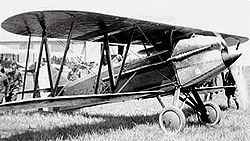Curtiss PW-8
| Curtiss PW-8 | |
|---|---|

|
|
| Type: | Fighter plane |
| Design country: | |
| Manufacturer: | |
| First flight: |
January 1923 |
| Number of pieces: |
28 |
The Curtiss PW-8 model goes back to a biplane fighter aircraft with the original designation Curtiss L-18-1 (later designation: Curtiss Model 33 ) developed in 1922 on the initiative of the manufacturer Curtiss Airplane and Motor Company Incorporated . The selected abbreviation PW serves as an indicator of the planned use of the machine as a follower ( P ursuit) and the type of motor cooling ( W ater cooled).
The Curtiss PW-8 was a mixture of old and new construction details. In addition to the two-stemmed wooden wings, a modern metal fuselage and a cooler were used on the upper wings. The Curtiss XPW-8B variant formed the basis for the successful Curtiss P-1 Hawk fighter aircraft of the US Army Air Corps .
development
The first prototype XPW-8 was built in late 1922. The first flight took place in January 1923. In April 1923 this prototype was bought by the US Army Air Corps . This purchase was followed by two more, with the second prototype produced having an improved streamlined shape and a modified chassis. The generally improved performance led to a production order for 25 copies on September 25, 1923. The third prototype was further modified and received new single-handle wings. This machine, named XPW-8A ( Curtiss Model 34 ), was briefly tested with a new cooler on the wing center section of the upper wing before it was finally replaced by a cooler in the bow. After delivery and subsequent use in the Pulitzer Trophy Air Race in 1924, this prototype with new trapezoidal wings was named XPW-8B .
commitment
On June 23, 1924 Lieutenant Russel L. Maughan completed the first night flight over the USA with an early production copy of the Curtiss PW-8 .
The prototype Curtiss XPW-8A took 3rd place in the Pulitzer race in 1924.
variants
- XPW-8: Name of the first two prototypes
- XPW-8A: Third prototype with modified wings and bow engine cooler
- XPW-8B: Prototype XPW-8A converted with trapezoidal wings. Starting point for the Curtiss P-1 Hawk
- PW-8: Designation of the series version
Technical specifications
| Parameter | Data |
|---|---|
| Type | single-seat combat biplane |
| Engine | 1 × in-line engine Curtiss D-12 , 440 PS (324 kW) |
| Top speed | 275 km / h at sea level |
| Service ceiling | 6205 m |
| Range | 875 km |
| Empty mass | 991 kg |
| Max. Takeoff mass | 1431 kg |
| span | 9.75 m |
| length | 7.03 m |
| height | 2.76 m |
| Armament | 2 × 7.62 mm machine guns |
literature
- AERO, Marshall Cavendish International Ltd., 1984 London England issue 56